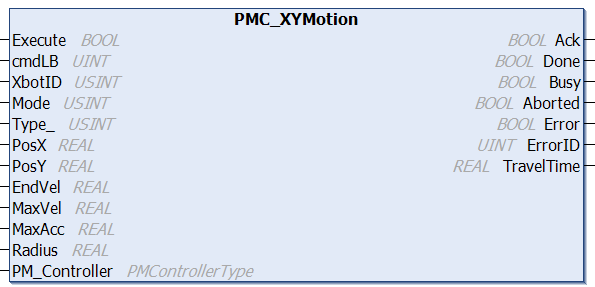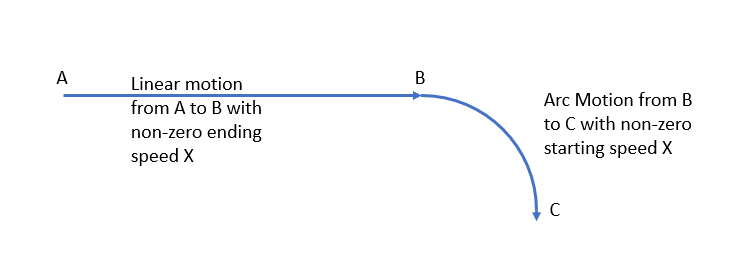XY Motion
The linear motion command can be used to move the XBot towards the target position in a few ways:
Direct (straight line)
Move along the X-direction first, then move along the Y-direction
Move along the Y-direction first, then move along the X-direction

Fieldbus Interface
PMC_XYMotion
Ethernet Interface
MotionRtn LinearMotionSI(ushort cmdLabel, int xbotID, POSITIONMODE positionMode, LINEARPATHTYPE pathType, double targetXmeters, double targetYmeters, double finalSpeedMetersPs, double maxSpeedMetersPs, double maxAccelerationMetersPs2, double cornerRadius = 0)
Conditions
Operating Conditions | |
|---|---|
Preconditions | XBot is in the Idle state, Obstacle Detected state, Motion state, Stopped state, Hold Position state, or Waiting state. |
Postconditions | If the XBot is ready to immediately begin executing the command, then the XBot will enter the Motion state. Otherwise, the XBot state remains unchanged, but the command will be added to the XBot's motion buffer. |
Description
The linear motion command can be used to move the XBot towards the target position in a few ways:
Direct (straight line)
Move along the X-direction first, then move along the Y-direction
Move along the Y-direction first, then move along the X-direction
Only the X- and Y-positions (also called the long axis) are controlled by this command. The Z-, Rx-, Ry-, and Rz-positions are maintained during this motion command.
Using this command in X-then-Y or Y-then-X mode will send two separate linear commands with the same command label to the XBot. Direct mode only counts as one linear command.
The target position can be specified either in absolute coordinates or relative coordinates. Relative coordinates are relative to the reference position of the XBot when the command begins execution. The maximum speed and acceleration must be specified. The input maximum speed and acceleration will be automatically adjusted if they are below or above the configured system limit settings.
Ending speed:
The desired ending speed must also be specified:
Ending speed = 0 means that the XBot will stop at the end target position
Ending speed > 0 can be used to connect multiple motion commands seamlessly (see below)
If the ending speed is unachievable within the distance available between the starting and end positions, the PMC will automatically limit the ending speed to an achievable value

If the ending speed is non-zero but no motion command is available to be run by the XBot when it is done executing the initial linear motion command, the XBot will:
Begin decelerating to a complete stop after reaching the target position
Backtrack to the target position in the shortest time possible after stopping completely
Therefore, it may appear as though the XBot has overshot its target position. If the target position is located close to the flyway boundary and would cause the overshoot to exceed the flyway boundary, then the command will be rejected
Blended Motion:
When a radius greater than 10 um is specified and the path type is either X-then-Y or Y-then-X, an arc motion will be automatically inserted between the two linear motion commands.

If a radius smaller than the minimum radius needed to maintain the specified maximum speed is inputted, the PMC will automatically lower the speed to a value within system limits. Blended Motion cannot be currently added to a Motion Macro.
The radius value is ignored if the path type is Direct.
Changelog
PMC v117.11.6 - Added Radius, which enables blended motion when path type is X-then-Y or Y-then-X
